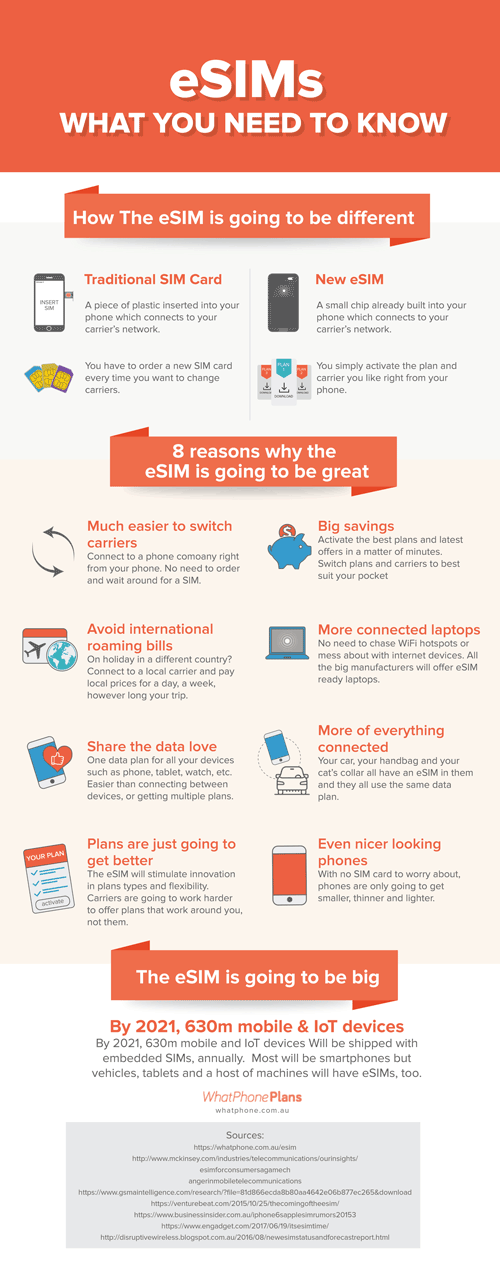What is eSIM?
eSIM technology is expected to change the way telcos market their services, as well as improve customer experience. The eSIM is essentially an embedded SIM, built into the device so you don’t have to physically plug in a SIM card from a service provider.
eSIM technology has been available in Australia since 2017, and mostly debuted in smaller devices like smart watches. Today, tablets, laptops, and smartphones like Apples iPhone models come with eSIM technology, forcing telcos to provide service plans that allow those devices to be fully functional on their networks.
In this post, we’ll tell you all about the benefits of eSIM, as well as the Australian telcos that support the technology.
Australian telcos that support eSIM
Australian telcos have supported eSIM technology since 2017. For now, only MNOs (Mobile Network Operators) support eSIM in Australia – Telstra, Optus, and Vodafone. And although the ACCC has chosen not to regulate access to the technology right now, they are keeping an eye on the fact that MVNOs haven’t been granted access to eSIM technologies yet – a fact that may suggest smaller telcos will soon be granted eSIM support.
To switch to a Telstra, Optus, or Vodafone plan via eSIM technology, you’ll need an eSIM device. Here’s a look at some popular devices currently on the market with eSIM capability:
- Apple Watch, 2017 and newer.
- Apple iPhones, 2018 and newer.
- Microsofts’s Surface Pro 4G LTE and the HP Sceptre.
- Google’s Pixel 2 and Pixel 2 XL.
You can compare SIM only plans here, but we’ve also curated the best eSIM deals in Australia here.
All you need to know about eSIM technology.
Benefits of eSIM technology
For telcos, the eSIM could pose some challenges to their bottom line. The technology, in essence, provides several benefits for the consumer that telcos might find threatening.
- First, if you own an eSIM-compatible device, you can switch telco offers from your device without having to get a SIM from the telco. The switch takes place digitally, making it easy to switch whenever you want – whenever you see a better offer than your current telco is giving you. This means your telco will be operating in an even more competitive environment than it already is, constantly striving to match any cheaper, value-driven offer that pops up sporadically from other telcos, given the ease at which you could switch.
- Second, the mere fact that you can switch digitally takes away the practice of telcos locking devices to their networks alone. Telcos benefit from selling you a device that’s only compatible with their network and, therefore, their offers. Although it might still be possible for telcos to lock eSIM devices, it seems like an unlikely and unattractive move. Taking this away from providers means they’ve lost all control, placing all bargaining power in the customer’s hands.
But whether service providers like it or not, the eSIM will eventually become a widespread, mainstream technology. This is because it can turn pretty much any device into a wireless network-compatible device. For instance, imagine heavy machinery that come with an embedded SIM, connecting to a mobile network to take advantage of Internet of Things applications.
We’ve already seen the eSIM growing in popularity with both governments and major technology firms around the globe. Last year, the EU mandated eCall, an eSIM technology in cars that alerts first responders whenever an automobile accident occurs. And earlier this year, we also saw Ericcson announce that they will now take a fully-eSIM approach to all their devices.
The fact is, though, that the eSIM isn’t doom and gloom for telcos. As Ericcson pointed out, carriers can benefit from the eSIM if they market their services the right way. Also, eSIM can also prove to be a cost-saving technology for telcos:
- For instance, one major reason why telcos still maintain retail stores is to provide customers with physical SIM cards. With the eSIM, telcos can take a completely digital approach to selling service plans, closing down several retail shops to save a ton of overhead costs.
- That fully digital approach also eliminates postal costs for delivering SIM cards to customers, as well as manufacturing costs for producing physical SIM cards. Predictions of a 16% drop in SIM card shipments due to the emergence of eSIM technology are already being touted.
Summary
The eSIM is still in its early stages in Australia, despite being in the country since 2017. Today, only the major carriers Telstra, Optus, and Vodafone offer eSIM support, and the ACCC has expressed concern as to why smaller telcos or MVNOs haven’t been given access to the technology. Perhaps, with time, those smaller telcos will gain access to the larger telcos’ eSIM support, which would make the technology mainstream as more eSIM plans and deals will enter the market.
However, the eSIM is only as popular as the devices that support the technology. So far, only a few devices on the market are eSIM-capable, with the biggest smartphone brand being the Apple iPhone. As more manufacturers begin to adopt eSIM support, expect the number of eSIM service providers in Australia to increase as well.
